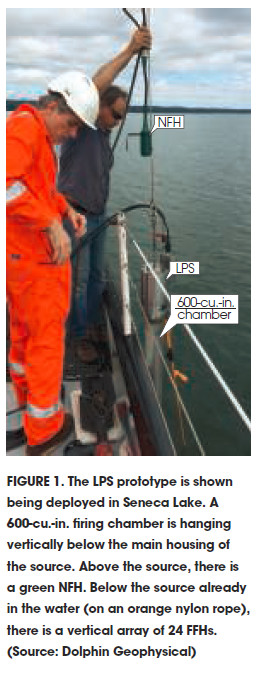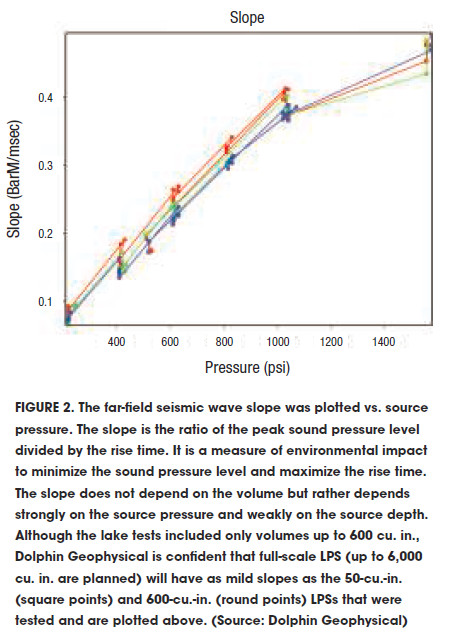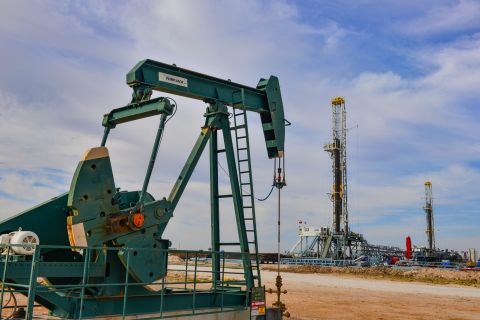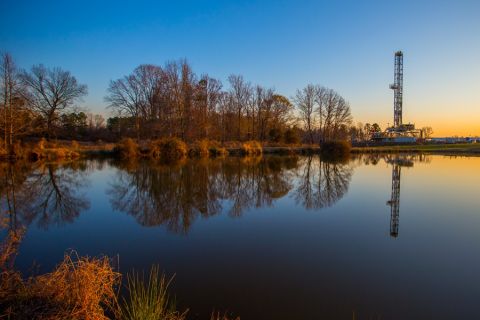About 150 years ago, the oil industry saved many whales from extinction. About 50 years ago, airguns saved much human and animal life. In the future, renewable sources of energy might replace hydrocarbons, and during the transition period the remaining oil and gas are increasingly more difficult to find and produce. Finding these hydrocarbons will require improved seismic methods, in particular, seismic sources with increased low-frequency content and reduced environmental impact.

The low-pressure source (LPS) is an evolution of the conventional airgun; it is designed to operate at lower pressure but higher volume. Conventional airguns operate at 2,000 psi and have volumes of 40 cu. in. to 2,000 cu. in. An LPS operates at 600 psi to 1,000 psi and has volumes of 1,000 cu. in. to 6,000 cu. in. The lower pressure enables the volume increase without increasing the weight and the number of guns in the source array.
In addition to larger volume, another modification that is enabled by lower pressure is larger ports that wrap twice as far around the source, with a total area that is four times that of a conventional airgun. Another new design feature of the LPS is a reduced acceleration distance. Rather than the jets of air that are initially shot into the water by conventional airguns, the LPS produces an annular ring of air that forms an expanding bubble. Instead of whistling jets of air, the expanding bubble radiates low-frequency waves. The LPS thus emits less high-frequency acoustic energy that has little or no geophysical utility for exploration and reservoir model building. It wastes less high-frequency noise and produces more low-frequency signal.
Operational impacts
Upgrading from conventional airguns to an LPS should have a small impact on seismic operations. There will be minor modifications to the compressors, to the umbilicals and to the source control systems. Seismic crews will be able to upgrade from airguns to LPSs with no or little delay. There also will likely be minor changes to data processing because although the time duration of the LPS pulse is longer than conventional high-pressure airguns and the peak-to-bubble ratio is smaller, the bubble is effectively not moving while radiating seismic waves, so there is no need for source motion correction in processing. The smaller peak-to-bubble ratio increases the dependency on improved source designature. However, this is an evolution of seismic data processing that is already underway for the purpose of broadband processing of conventional airguns; the low-frequency acoustic waves that are radiating from the bubble can be treated as signal and not as noise. The bubble has the desired amplitude but the wrong phase; it is coming some time after the main pulse. The phase (or timing) can be fixed without harming the amplitude in processing.

Seneca Lake test
As a proof of concept, the authors deployed an LPS prototype at Seneca Lake and recorded data with near-field and far-field hydrophones (NFH and FFH; Figure 1). The prototype had two firing chambers: a 50-cu.-in. chamber and a 600-cu.-in. chamber. The large volume was shot at pressures varying from 200 psi to 1,000 psi and the small volume from 500 psi to 2,000 psi. An NFH was tied 1 m (3.3 ft) above the LPS and recorded data at a 0.5-ms interval (2 KHz sampling and 1 KHz Nyquist frequency). The FFHs were a vertical array of 24 hydrophones. The nearest one was 75 m (246 ft) below the LPS, and the farthest was 121 m (397 ft) away, with a 2-m (6.5-ft) vertical interval between hydrophones. The FFH, sampling at 31.25 microseconds (32 KHz sampling, 16 KHz Nyquist frequency), provided much better data than the NFH. About 300 shots were recorded over two days. Shots at the same depth, volume and pressure were repeated three to six times to test the repeatability.
Several attributes from the Seneca Lake data were extracted and analyzed. Figure 2 shows two key attributes: The slope (rate of rise in pressure to the primary peak) is a measure of environmental impact, and the ratio of energy in low frequency to energy in high frequency is a measure of geophysical quality. The attributes are plotted against pressure with source depth encoded in color; red is 5 m (16.4 ft), green is 7.5 m (25 ft) and blue is 10 m (33 ft). With three to six times with the same parameters, the data show excellent repeatability.
The improvement in environmental impact was greater than expected (Figure 3). The improvement in geophysical quality was encouraging, and significant improvement in low-frequency content is expected with full-scale volumes and full design features.
With significant environmental and geophysical advantages and with minor changes to seismic acquisition and processing, the LPS is expected to replace conventional airguns as the main seismic source for E&P and development.

Recommended Reading
EIA: Permian, Bakken Associated Gas Growth Pressures NatGas Producers
2024-04-18 - Near-record associated gas volumes from U.S. oil basins continue to put pressure on dry gas producers, which are curtailing output and cutting rigs.
‘Monster’ Gas: Aethon’s 16,000-foot Dive in Haynesville West
2024-04-09 - Aethon Energy’s COO described challenges in the far western Haynesville stepout, while other operators opened their books on the latest in the legacy Haynesville at Hart Energy’s DUG GAS+ Conference and Expo in Shreveport, Louisiana.
Mighty Midland Still Beckons Dealmakers
2024-04-05 - The Midland Basin is the center of U.S. oil drilling activity. But only those with the biggest balance sheets can afford to buy in the basin's core, following a historic consolidation trend.
Mesa III Reloads in Haynesville with Mineral, Royalty Acquisition
2024-04-03 - After Mesa II sold its Haynesville Shale portfolio to Franco-Nevada for $125 million late last year, Mesa Royalties III is jumping back into Louisiana and East Texas, as well as the Permian Basin.




